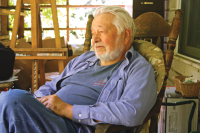When is it safe to plant?
By Jim Janke
When is it safe to plant tender annuals and vegetables in Haywood County? The standard answer we give in the plant clinic is May 15th. Before then you risk damage from a frost. But is May 15th really the last frost date? And what can you do if a frost occurs after planting?
Based on data from National Oceanic and Atmospheric Administration, the average last frost date in Waynesville since 1948 is actually May 5. You have a 50:50 chance of frost after that date. May 15 is the 80 percent safe date, so planting then is reasonably secure. The absolute last frost date is after June 1! (See the accompanying chart.)
Remember that the chance of frost depends on your elevation, exposure, and microclimates. But in general waiting until May 15 will avoid frosts the vast majority of the time.
The problem for most of us is impatience. Annual and vegetable plants appear in garden centers, tempting you to plant them early. Then if a frost occurs the plants are gone. Or late in the season you don’t get a chance to cover your plants when frost is predicted, and everything is dead the next day.
One way to minimize frost damage is to wash the frost off the plants. A heavy frost will kill most tender annuals and vegetables unless they are covered or protected. But if a light frost occurs simply hose off the plants with a fine water spray before the sun hits them in the morning, in effect washing the frost off the plant. Depending on the specific plant type and the amount of frost, this can minimize damage down to 30 degrees or lower.
Why does this work? The amount of heat required to melt ice is 80 times the amount of heat needed to increase the temperature of water 1 degree. When the frost melts, it takes this heat primarily from the plant tissue, killing the plant. But if you wash off the frost, the water spray melts the frost and warms the plant. Its chances of survival improve dramatically.
Make sure you wet all the leaf surfaces. Spray the plants just before sunrise, so the wet leaves don’t have a chance to re-freeze.
Fruit growers use a different technique: they spray water all night to deliberately form ice on the fruit. The ice insulates the fruit from even colder air temperatures. This wouldn’t work for tender annual and vegetable plants, which can’t take the lower temperatures that fruit trees and vines can.
Remember to disconnect the hose from the faucet the previous evening, and drain the hose. A frozen hose will be difficult to use in the morning!
Jim Janke is a Master Gardener Volunteer in Haywood County. For more information call the Haywood County Extension Center at 828.456.3575.





